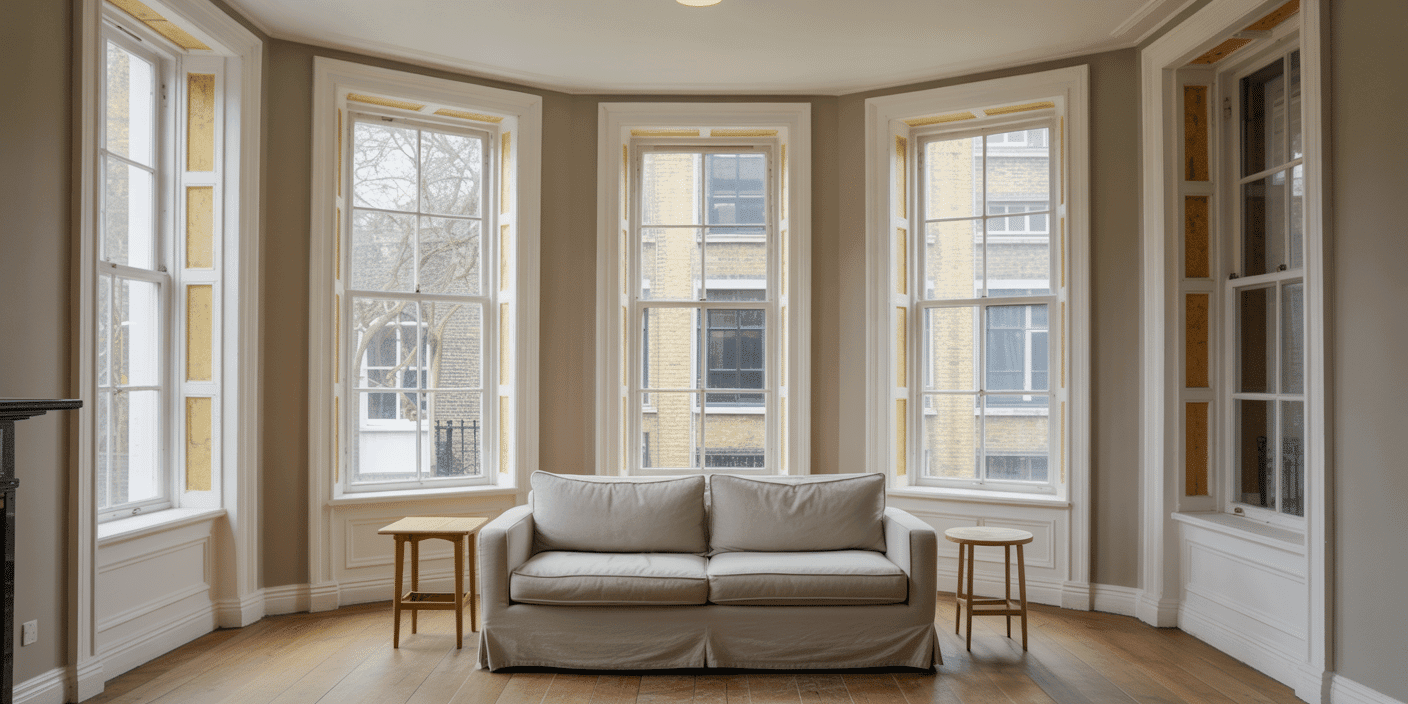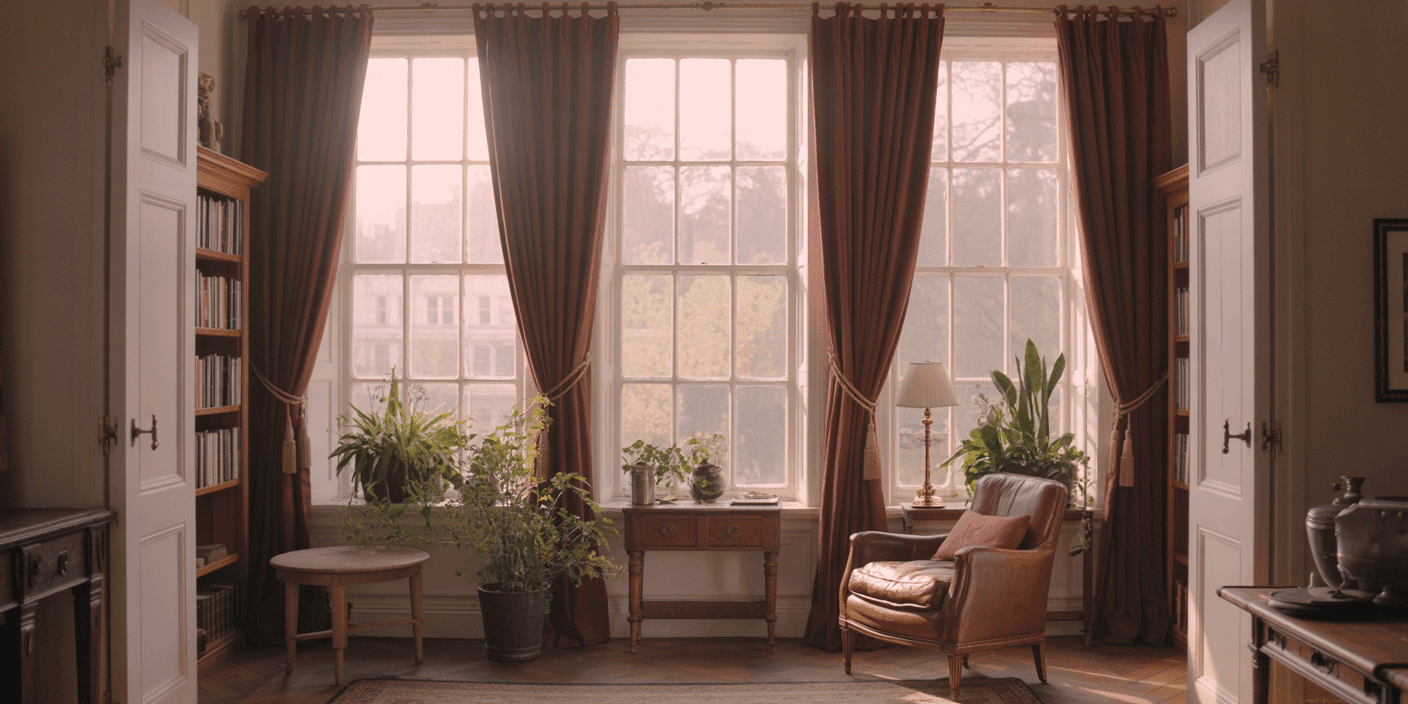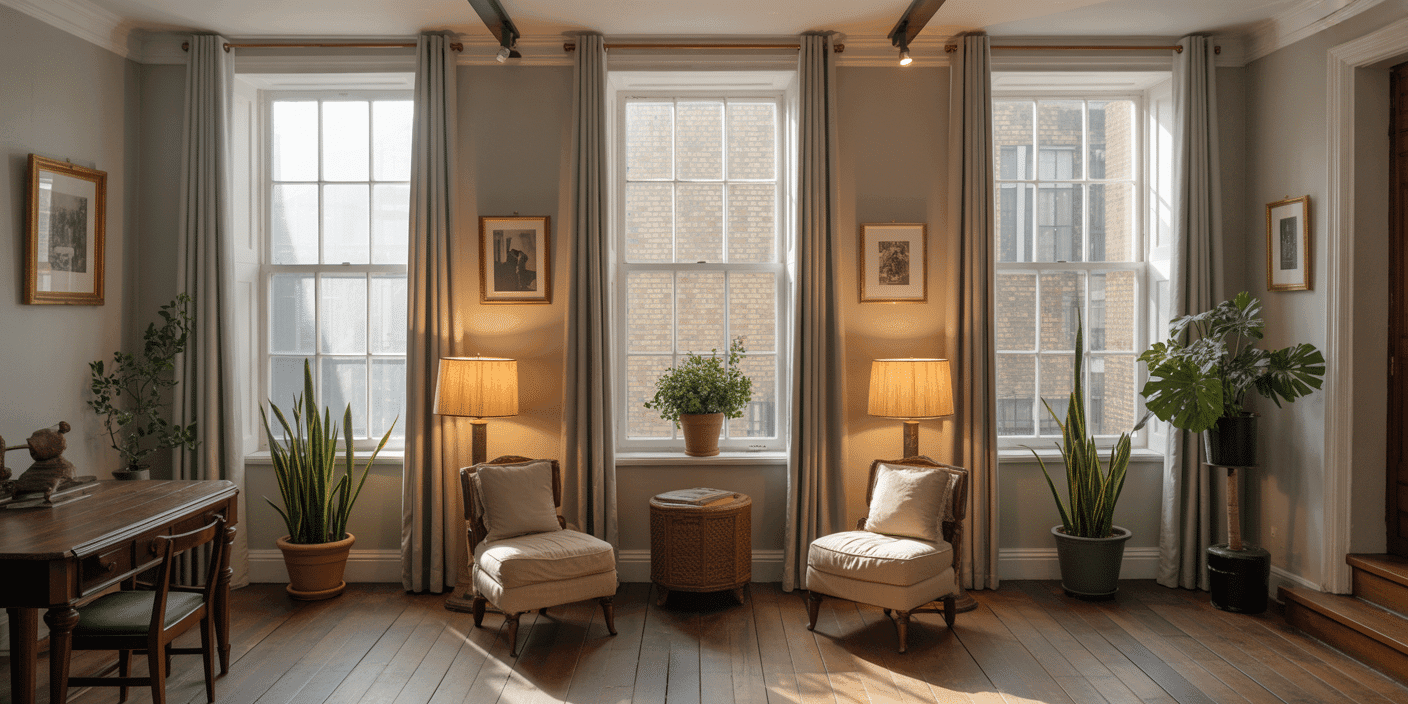Sub-1.0 Windows in the UK? Yes—But Few Can Deliver Them.
Windows with a U-value below 1.0 W/m²K are not theoretical. They exist. They are specified. And they are being fitted—quietly, expertly—into homes across the UK. The true surprise is not their availability, but how few companies are equipped to engineer and install them.
Despite a marketplace saturated with talk of “energy efficiency,” the majority of systems sold barely meet regulatory minimums. By contrast, sub-1.0 performance belongs to a different category altogether. It is not the product of mass manufacture. It is not rushed to market. It is built—deliberately—with the precision of an engineered system.
Most conversations begin with a well-meaning claim: that modern double glazing will keep a home warm. In practice, this is rarely the case—especially in older or architecturally sensitive buildings, where heat loss is more complex and expectations are higher. The threshold of 1.0 is not marketing bravado; it is the point at which a window ceases to be a thermal liability and becomes a critical element of an insulated envelope.
Yet many homeowners—and even professionals—remain unaware of what this level of performance entails. They assume all “high-performance” windows are functionally equivalent. That a U-value of 1.4 is nearly as good as 0.9. The brochure value matches real-world performance once the system is installed and tested against a British winter. These assumptions are incorrect.
Achieving a U-value below 1.0 demands a very specific configuration: engineered timber or composite frames, calibrated glazing assemblies, and airtight installation protocols executed with near-craftsman precision. Few providers are capable of delivering all three—fewer still within the constraints of conservation area planning or listed building guidelines.
That scarcity is not coincidental. Sub-1.0 systems are difficult to specify and harder still to install correctly. They require technical fluency, design sensitivity, and an operational model that prioritises quality over volume. But when delivered well, the impact is transformative. Rooms become quieter. Internal temperatures stabilise. Bills fall. And a standard of comfort emerges that is felt—not just claimed.
This is not about exceeding regulation. It is about building to a higher expectation. One that respects heritage, embraces performance, and elevates the home itself.
What Exactly Is a U-Value—and Why Should You Care?
Let’s cut through the jargon:
A U-value measures how much heat a building element loses. It’s written in W/m²K—watts per square metre per degree Kelvin. The lower the number, the better it insulates. The slower your heat escapes.
In simple terms, think of it like this:
If your home is a thermos flask, your windows are either helping it stay warm—or leaking energy by the second. A poorly fitted sash window with thin double glazing might have a U-value of 2.8. A well-engineered, triple-glazed, timber-framed system can drop below 1.0. That difference can save hundreds of pounds a year and eliminate cold zones, condensation, and constant fiddling with the thermostat.
But there’s a twist most homeowners don’t see:
Window manufacturers often quote the glass U-value—not the full window U-value.
That’s misleading. Because your frame, spacers, gas fills, seals, and installation method all affect actual performance. A centre-pane value of 0.9 sounds great—but if the frame bleeds heat like an exhaust pipe, your whole window value might still be 1.8 or worse.
That’s why we talk about whole-system U-values. Because unless every element of the window system is engineered and installed correctly, you’re not buying performance. You’re buying a number on a label.
What Do the Building Regulations Really Require?

If you’ve ever tried to read Part L of the UK Building Regulations, you’d be forgiven for wanting to throw it out the window—ironically, likely one that leaks heat.
So here’s what matters, in plain English:
- For new homes: your windows must achieve a U-value of 1.2 W/m²K or better
- For existing properties: window replacements must hit 1.4 W/m²K or better
- Passivhaus standard? That’s a U-value under 0.8 W/m²K—exceptional, but not legally required
This means a window with a U-value under 1.0 isn’t just compliant—it’s outperforming the regulatory bar. And that’s exactly the point.
Part L isn’t the gold standard. It’s the legal minimum.
For property owners, specifiers, and developers operating in premium postcodes or within conservation constraints, minimums aren’t enough. Not when you’re investing in a building expected to last another 100 years. Not when you want your heating bills cut in half. Not when your home deserves to be quiet, warm, and architecturally correct.
And here’s the nuance most overlook:
Even if your windows tick the thermal box, they may fail under Part Q (security) or get flagged by conservation officers if the sightlines or glazing profiles aren’t right. One mismatch, and your installer may be tearing them out before the paint dries.
That’s why true performance means more than just numbers. It means integrating thermal compliance with aesthetic credibility, security certification, and airtight install protocols—all at once.
That’s not common. But it’s exactly where the right supplier earns their reputation.
Why Most ‘Energy Efficient’ Windows Still Leak Heat
Here’s the uncomfortable truth most suppliers won’t say out loud:
The average “energy-efficient” window doesn’t perform anywhere near its brochure specs once it’s installed.
It’s not because of bad intentions. It’s because the system is only as good as its weakest part—and in most cases, there are many.
Let’s break it down.
1. The Frame
Most manufacturers quote the centre-pane U-value of the glazing unit. That’s like advertising the fuel efficiency of a car going downhill with a tailwind. It ignores the frame, which is often a major point of heat loss.
- uPVC frames, despite being cheap, tend to suffer from poor thermal breaks and flex over time.
- Aluminium frames without proper thermal isolation behave like heat sinks.
- Even low-grade timber, if not properly treated or sealed, can warp and leak.
A true high-performance frame—like Accoya or alu-clad composite timber—costs more, but seals tighter, insulates better, and lasts longer.
2. The Spacer Bars
Between your panes of glass sit tiny spacer bars. If these are metal or poorly constructed, they conduct heat straight out of your home.
→ The best systems use warm-edge spacers designed to reduce thermal bridging at the edges.
3. Gas Fill + Glazing Cavity
Argon gas is standard. But for sub-1.0 performance, krypton gas or triple-glazed units with increased cavity spacing may be required.
→ Most mass-market suppliers don’t offer these unless you ask—and pay extra.
4. Installation Quality
This is the silent killer of performance. Even the most advanced window can underperform if it’s:
- Poorly sealed
- Misaligned
- Installed into an uninsulated or irregular opening
Gaps get filled with cheap foam. Seals get compressed. Frames twist. And your heat leaks out while you assume you’re saving money.
So What Does It Take to Do It Right?
Performance is never an accident. It’s engineered from frame to finish, then protected during installation by technicians who understand airtightness, pressure points, and compliance sequencing.
And yet most window companies treat installation like a side hustle, not a science.
That’s why it’s rare to find a system that genuinely delivers a U-value under 1.0 in the real world—especially one that also pleases planners, satisfies conservation officers, and keeps its shape 20 years from now.
But when you do, it doesn’t just keep your home warm.
It keeps your money in your wallet, your silence inside the house, and your standards where they belong: above regulation.
Inside the Systems That Actually Beat the 1.0 Barrier
Let’s be blunt:
You don’t get sub-1.0 U-values by shopping from a catalogue. You get there by engineering a precision system, every component working in harmony to seal, insulate, and perform.
This isn’t “off-the-shelf” double glazing. It’s the architectural equivalent of a bespoke Savile Row suit: tailored, layered, purpose-built. Below are the elements that separate real high-performance window systems from marketing mirages.
1. The Frame: Thermal Backbone of the System
Most heat loss occurs at the junction between glazing and frame. Which is why your choice of frame isn’t just aesthetic—it’s structural to performance.
- Accoya or engineered hardwoods: These modified timbers offer minimal thermal conductivity, high dimensional stability, and resistance to warping or swelling.
- Alu-clad timber composite: Combines the thermal benefits of timber internally with a durable, weatherproof aluminium shell externally.
- Thermally broken frames: In aluminium systems, this is non-negotiable. A proper thermal break prevents the frame from acting like a radiator to the outside world.
👉 If your frame isn’t engineered for thermal resistance, your glass is irrelevant.
2. The Glass: Beyond the Brochure Spec
To reach below 1.0, you’ll need more than standard double glazing.
- Triple glazing: Adds a second cavity for thermal layering
- Low-E coatings: Reflect interior heat back into the room
- Krypton or Argon gas fills: Increase insulation by slowing conduction
- Optimised cavity width: 12–16mm is optimal; too narrow or too wide affects gas performance
But remember—glass is only half the system. On its own, it’s just numbers. Combined with the right frame, it’s performance.
3. Warm Edge Spacer Bars: The Hidden Heroes
Standard aluminium spacer bars act as thermal bridges. Warm edge spacers, often made from composite or stainless steel, reduce edge conduction—the most overlooked leakage point in the entire unit.
→ Without them, your cold corners sweat, and your U-value climbs.
4. Installation Method: The Make-or-Break Moment
Even a passive-rated window will underperform if installed like a plastic throwaway.
- Airtight membranes or tapes should seal the perimeter
- Compressible foam or expanding thermal sealants must be used precisely
- True squareness and plumb installation ensure sash alignment and weatherproofing
The best window systems demand skilled joiners, not general fitters. This is where most projects fall apart—and where legacy builders like Sash Windows London excel.
5. Certification and Verification
If you can’t prove it, don’t believe it.
You should expect documentation showing:
- Whole-unit U-value (not just centre-pane)
- BFRC performance certificates
- PAS 24 or Part Q compliance
- SAP rating improvement projections
Anyone can say “high-performance.” Only specialists back it with science.
So Yes—Sub-1.0 Is Possible.
But it requires more than a pretty window with a glossy brochure.
It demands integrated materials, certified glass, airtight fitment, and a team who understands thermal performance as a system—not a product.
That’s not every installer. But it is a very specific kind of window company. And they tend to be the ones who show up on conservation officer shortlists and PassiveHaus supplier rosters.
The ones who know that performance is legacy—not just compliance.
Is This Overkill or a Smart Upgrade?

If you’ve made it this far, you’re probably asking:
“Do I really need windows with a U-value under 1.0?”
Here’s the answer:
Maybe not. But if you’re serious about thermal performance, long-term energy savings, environmental impact, or architectural integrity—then yes, you absolutely should consider it.
Let’s break it down.
1. High-End Homeowners
You’ve invested in a premium home—why settle for commodity windows that bleed heat and let noise creep in?
- Sub-1.0 U-values keep large, open spaces consistently warm
- They prevent thermal shock near glazing—no more cold zones around French doors or bay windows
- Reduce external noise to a hush—essential in central London or roadside properties
And let’s be honest: insulation is invisible. But comfort isn’t. You’ll feel it daily.
2. Architects & Specifiers
Whether you’re working on a new build or a sensitive restoration, sub-1.0 systems help you future-proof your design and performance envelope.
- Better SAP scores without resorting to clunky interventions
- Compliant with Part L today—and likely still compliant tomorrow
- Essential in PassiveHaus-adjacent projects or zero-carbon mandates
→ Clients will thank you at the snagging stage—and even more on their heating bills.
3. Eco-Renovators & Passive Projects
You’ve likely already considered:
- Heat pumps
- MVHR
- Solar PV
- Airtight membranes
Why pair all that with average windows?
- Sub-1.0 windows preserve the investment you’ve made in thermal strategy
- They close the weakest link in the envelope
- A must-have for PassiveHaus or near-Passive performance
→ Anything less is a thermal contradiction.
4. Conservation or Listed Property Owners
This is where things get interesting. You’re under pressure to preserve historic style—but still want 21st-century comfort.
- Sash Windows London, for example, offers slimline systems that meet planning expectations and perform to <1.0 specs
- Discreet brush seals, multi-layered glazing, and thermally optimised frames mean no compromises
- It keeps your planner happy—and your heating bills lower
This is prestige restoration done properly. Not plastic pastiche or drafty replicas.
5. Anyone Who’s Ever Said “This Room Is Always Cold”
Let’s not overcomplicate it. If your window areas are the coldest parts of your home, that’s heat you’re paying for—and losing.
- Sub-1.0 systems cut heat loss dramatically
- Fewer radiators needed in front of glazing
- Eliminates that “cold wall” sensation in winter
You don’t need to be an architect or environmentalist to want a warm home that performs silently and efficiently.
Who’s It Not For?
- Volume builders chasing lowest tender: They’re optimising for margin, not comfort
- Rental landlords on short-term yield models: Heat loss isn’t their bill
- Buyers looking for the cheapest possible fix: These systems are investment-grade
But if you’re building or restoring a home to keep, why not do it properly the first time?
The Sub-1.0 Buyer’s Checklist: How to Avoid Greenwashing
Let’s be clear:
When it comes to window performance, most marketing language is designed to sound intelligent without telling you anything meaningful.
Phrases like “energy efficient,” “high performance,” or “eco glazing” are vague by design. What you need is data. Proof. Specifications. And most of all—the right questions.
So here’s the checklist we give our own clients—the same one architects, conservation officers, and technical consultants quietly use to cut through sales talk.
1. What’s the Whole-Window U-Value?
- Not just the centre-pane U-value—you want the entire unit performance, including frame, seals, and spacer bars.
- Ask for: BFRC-certified whole-unit U-value.
- If they hesitate or don’t know—walk away.
2. Is the Frame Thermally Engineered?
- Timber? Composite? Alu-clad? uPVC?
- Ask:
- Is the frame thermally broken (if aluminium)?
- What is the U-value contribution of the frame alone?
- What treatment/stability processes are used (e.g. Accoya, multi-laminate)?
If the frame’s performance isn’t disclosed, assume it’s the weak link.
3. What Glazing Spec Is Included?
- You want details. Not fluff.
Ask: - Triple-glazed or double?
- Argon or Krypton gas?
- Warm edge spacers?
- Low-E coatings?
And don’t settle for, “Oh yes, it’s A-rated.” That’s a summary. Not a system.
4. How Is Airtightness Achieved?
- Ask: What sealing system is used around the window perimeter?
- Are airtightness membranes/tapes employed?
- Is the installation team trained in Part L airtightness compliance?
Most U-value degradation happens during fitting—not fabrication.
5. Can It Be Installed in a Conservation Area or Listed Property?
- A beautiful spec is meaningless if your council blocks it.
- Ask:
- Is the window Part L compliant and conservation-approved?
- Are traditional sightlines maintained with slimline triple glazing or heritage profiles?
Sash Windows London, for example, designs systems that are both planning-friendly and thermally elite—a rare combination.
6. What Certification Will I Receive?
You’re not just buying windows—you’re buying evidence.
Ask for:
- BFRC certificates
- Manufacturer U-value reports
- PAS 24 security compliance (if required)
- Part L conformance docs
- Installer warranty + airtightness declaration
If they can’t provide it in writing, it doesn’t count.
The Rule: If They Flinch at These Questions, They’re Not Your Supplier
A true high-performance window supplier will answer these faster than you can ask them.
They’ll be proud to show you thermal maps, U-value simulations, airtightness detailing, planning approval letters, and conservation officer feedback.
And if they can’t?
You’ve just saved yourself thousands—and a cold winter.
Ready for a Window That Delivers More Than a View?
It’s easy to fall for the brochure.
It’s even easier to accept what “everyone else is doing” when it comes to replacement windows or performance targets.
But the truth is this:
Most window systems are built to meet code, not to exceed it.
They do just enough to pass inspection, but not enough to transform how a space feels. How it functions. How it lasts.
A window with a U-value under 1.0 doesn’t just save energy.
It redefines your comfort zone.
- It keeps your living room warm at 6 am without a radiator ticking away.
- It silences city streets without secondary glazing.
- It makes your heating system more efficient, your spaces more consistent, and your property future-proof.
And perhaps most importantly, it does all this without compromising your architecture.
That’s not marketing. That’s proper specification.
It’s system-first thinking, backed by materials, joinery, and precision installation—delivered by craftspeople who understand conservation demands just as well as they understand SAP ratings.
This is where Sash Windows London operates quietly and consistently.
Not as a volume supplier. But as a long-term specialist, where performance and beauty are never at odds.
👇 Your Next Step
If this sounds like the kind of system your home deserves, here’s what to do:
- Download our “Low U, High Style” system spec pack
- Book a performance consultation with our conservation-trained advisors
- Request a thermal audit of your current windows—no sales pitch, just data
Because the right windows don’t just look good.
They keep you warm, quiet, protected—and proud.







